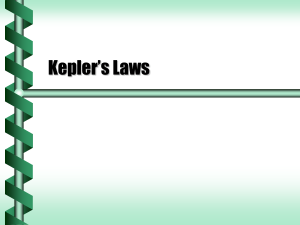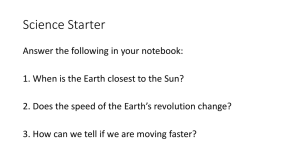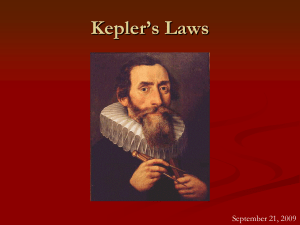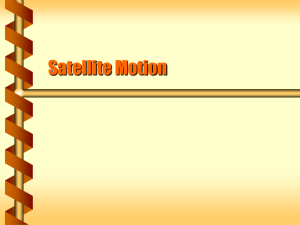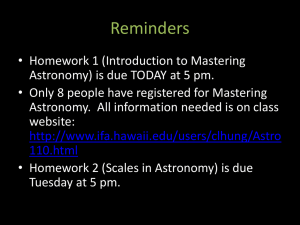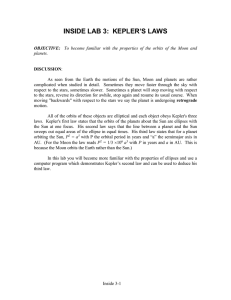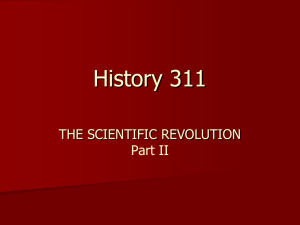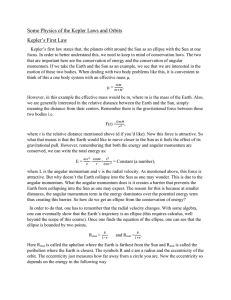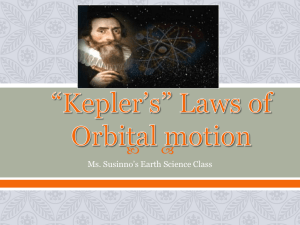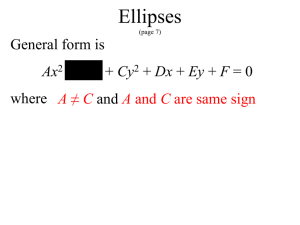Kepler's Laws Notes
advertisement
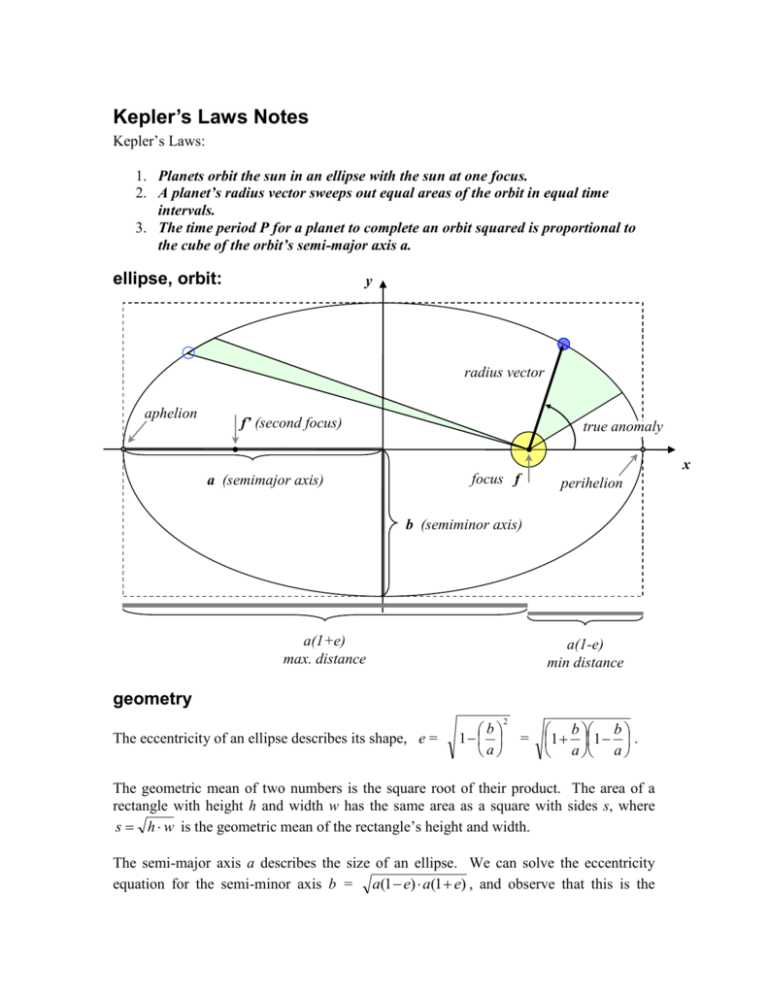
Kepler’s Laws Notes Kepler’s Laws: 1. Planets orbit the sun in an ellipse with the sun at one focus. 2. A planet’s radius vector sweeps out equal areas of the orbit in equal time intervals. 3. The time period P for a planet to complete an orbit squared is proportional to the cube of the orbit’s semi-major axis a. ellipse, orbit: y radius vector aphelion f’ (second focus) true anomaly x focus f a (semimajor axis) perihelion b (semiminor axis) a(1+e) max. distance a(1-e) min distance geometry The eccentricity of an ellipse describes its shape, e = b 1 a 2 = b b 1 1 . a a The geometric mean of two numbers is the square root of their product. The area of a rectangle with height h and width w has the same area as a square with sides s, where s h w is the geometric mean of the rectangle’s height and width. The semi-major axis a describes the size of an ellipse. We can solve the eccentricity equation for the semi-minor axis b = a(1 e) a(1 e) , and observe that this is the geometric mean of the minimum and maximum orbital distances, respectively, a (1 - e) from the primary focus to the perihelion, and a (1 + e) from the focus to the aphelion. b 1 e2 . Rewriting, one has b = a 1 e 2 and a If we can adjust the eccentricity so that e 0, b becomes a circle with radius r. a 2 = a = r, and the ellipse The area of an ellipse, A = a b = a 2 1 e 2 . The area of a circle, A = r 2. orientation We can describe the orientation of one ellipse to another in space like this: Start with two ellipses, E0 and E2, identical in size and shape and place, with the same focal point f. The perihelion point of E0 is P0 and of E2 it is P2. The ray f P0 is the direction we choose for our origin of a local-type top view coordinate system as seen in the ‘sky’ from the focus. Rotate E2 around the focus in its base (horizon) plane in the direction of orbital motion in E0 by a yaw angle he perihelion point P2 now has an azimuth angle of with respect to the ray elevated view f P0. Raise P2 straight up from the horizon by a pitch angle , using the focus f as a pivot point for the E2 plane. As seen from the focus, the local coordinates of P0 are (0º alt, 0º Az) (always) and the coordinates of P2 are now ( alt, Az). We can twist E2 around the line through f P2 to match the path of an object orbiting in E2: this twist is a third roll angle, , but it does not change the location of P2 in the sky. These three angles completely describe the orientation of the plane of E2 with respect to the original orientation given by the plane of E0 , f, and P0. (The angles and are small for the solar system planets because they orbit in or nearly in the plane of the ecliptic.) discussion The focal point for the solar system is the center of mass point CofM of the solar system, which is near or inside the mass of the sun. If we were at that point, we could expect to see the planets move around us in planes; but, since we are on Earth and orbiting the CofM ourselves, the apparent path of a planet in our sky is complicated by combined motions on different orbits (look ahead to the Retrograde Motion lab) and gravitational interactions. The size and shape of E2 are described by its semi-major axis a and eccentricity e. We can determine the shape (and orientation) of the solar planets’ orbits by observing the planets’ motion in the earth’s sky and recording when they are where. Using Kepler’s laws (see the Jovian Moons lab), we can figure out the size of the orbits as well. Kepler’s Law 2: A planet’s radius vector sweeps out equal areas of the orbit in equal time intervals. The planet obeys the law of conservation of angular momentum. For an object in orbit, the angular momentum is L = m r 2 , where m is the object’s mass, r is the distance from the center of mass of the (sun-planet) system, and is the angular velocity. Because the angular momentum is conserved, it is constant unless something from outside the sun-planet system acts to change it. When the object moves away from the CofM, r becomes greater, so must become smaller for L to stay the same. A classic analogy of conservation of angular momentum is that of the figure skater. If a skater is spinning with arms out, and then brings arms inwards towards the body (center of mass), the arms’ r is decreased. For L to remain the same with r smaller, must increase accordingly; and, this is what happens—the skater spins faster. To extend the idea into the the sense of orbits think of the sun and planet as pair skaters, where the center of mass is located nearest the much more massive sun, and the pull holding them together is gravity. Kepler’s Law 3: The time period P for a planet to complete an orbit squared is proportional to the cube of the orbit’s semi-major axis a, e.g. P 2 = k a 3, where k is some ‘proportionality’ constant. For the earth’s orbit around the sun, the equation and constant would be: P 2 = (1 yr 2 ) · a 3, 3 AU yr 2 3 a P = 1 3 AU yr 3 2 a = 1 3 2 AU When a is expressed in AU, the period P is found in years. (Sometimes the period is represented by T for time.)
